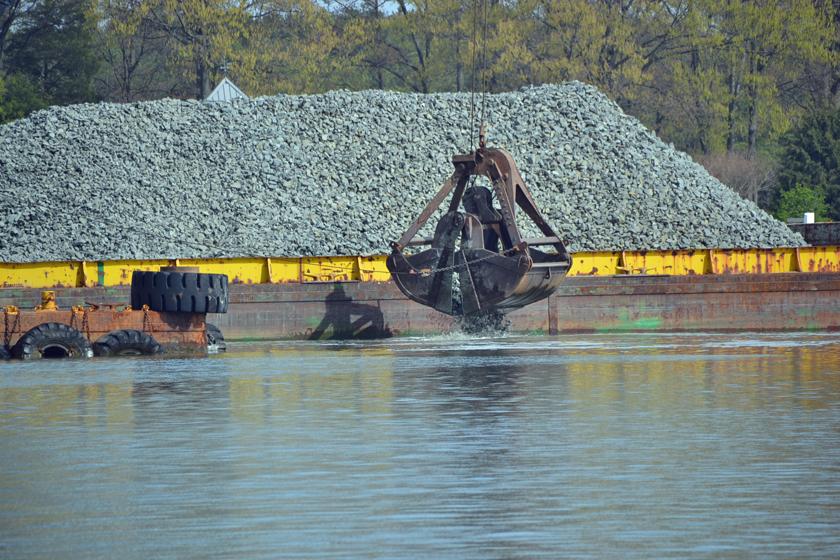The $31 million project to restore oyster habitat in Harris Creek is underway with 2013 restoration activities begun this week.
The first barge of the season’s contract started depositing 3,000 cubic yards of granite this week in Harris Creek between Wittman and Bozman, just off Rabbit Point. The granite will serve as substrate for oyster spat. The project will test several different types of substrate for oyster habitat at 13 sites covering 34 acres in Harris Creek. The substrates will include mixed shell and granite, and will be seeded with oyster spat.
Most of the existing oyster reefs in Harris Creek are silted under, as is true for much of the Chesapeake Bay. Harris Creek was selected for this project in 2010, and efforts have been underway to build a number of oyster reefs in various locations on the creek in order to enhance the oyster population. Harris Creek’s commercial oyster activity was halted in 2010 with the new oyster sanctuary regulations that closed the fishery completely for the foreseeable future.
The timing of the substrate drop makes sense. With water temperatures warming, the native oysters will begin to spawn soon. Since the new substrate is not covered with silt, but clean, it should be attractive for native oyster larvae to “strike” in the warm season. The area will be seeded with hatchery spat as well. Results of the summer’s spat set on this fresh substrate should be evident later in the season, and multiple government agencies will likely be monitoring the success of the project.
Oyster reefs are important for many reasons. Not only is the filtering capacity of the oyster a critical function of the Bay’s ecosystem, but the reefs themselves serve as habitat for many other native species, from plankton to worms to grasses, small fish and shellfish. The desired result of the project is the cumulative result of all of these species working in tandem with one another. Success will be measured not only by oyster production and water quality improvements, but an increase in other species as well. It is believed that a “tipping point” can be reached that will allow the natural ecosystem to sustain itself, supporting many species and improving water quality.
The price tag for the entire Harris Creek project is expected to reach $31 million. It is being monitored carefully by the many government agencies involved (MD DNR, NOAA, the Corps of Engineers), as well as local watermen who are not all convinced that the project has merit. Local watermen on Harris Creek were critical of the clam shell that was tested as substrate on the creek’s bottom last fall, and prefer that oyster shell be the only substrate that is placed on Bay bottom.
A second barge later this week will deposit shell on the bottom, and with input from watermen, the upstream sites are first on the list for re-building, said Claire O’Neill, Army Corps of Engineers Project Manager. By the end of this spring, the project will have placed on 56 acres at 19 sites over the past year and a half, she said.
News of a good spat set during the past two years has resulted in many people reporting lots of young oysters in Harris Creek as well as Broad Creek and other local waters. The presence of many year-old oysters is a sign that the natural spat sets were successful, and assuming no natural disaster wipes out local ecosystems anytime soon, a good sign that the state’s goals to enhance oyster habitat are being met.
To learn more about this project, visit:
https://chesapeakebay.noaa.gov/oysters/oyster-restoration-in-harris-creek
https://www.dnr.state.md.us/fisheries/pdfs/Harris_Creek_open_house_031512.pdf
https://chesapeakebay.noaa.gov/habitats-hot-topics/noaa-science-supports-harris-creek-oyster-project
https://www.oysterrecovery.org/harris-creek-project/
https://www.chesapeakebay.net/blog/post/from_the_field_rebuilding_oyster_reefs_in_harris_creek_md
https://www.bayjournal.com/article/harris_creek_oyster_project_offers_hope
..





Mike Basil says
Thirty one million dollars of tax payers money wasted. Broad creek which is located right next to Harris creek has more oysters thriving in it than Harris creek. Watermen there are able to support their families and the money they make goes back into the local economy. There was no tax payer money spent in Broad creek to restore the population. Watermen are allowed to work this area and keep the bars clean and naturally the oysters came back. The Harris creek project is a waste of tax payers money, and a waste of good oyster bottom that could be worked by watermen to make a living and put money back into the local economy.
Scott says
Let’s all cover are eyes and just pretend like the Chesapeake Bay hasn’t got a problem in the world.